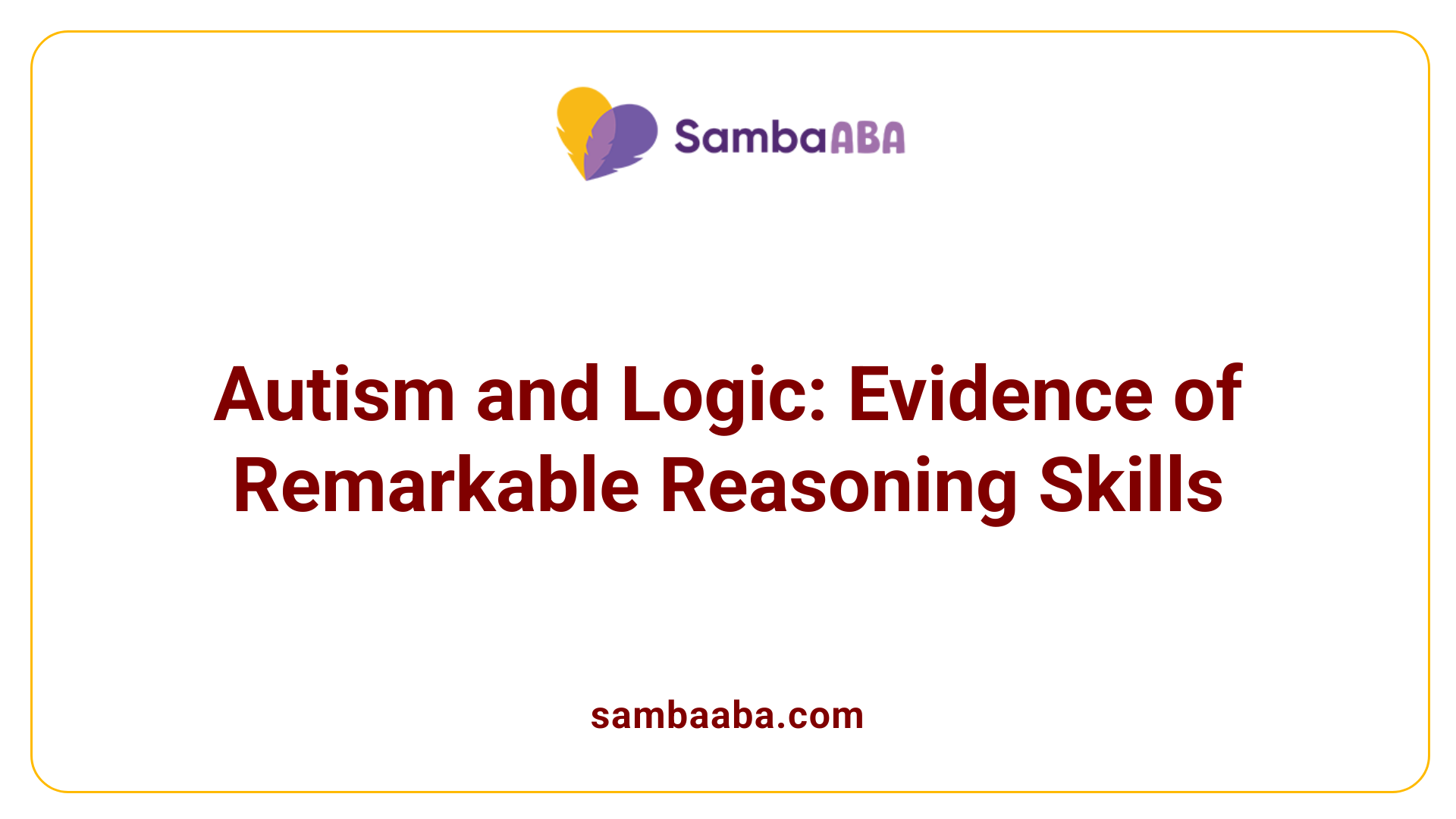Are Autistic People Better At Logical Thinking
Unveiling the Cognitive Profiles of Autistic Thinkers
Exploring the Logical Strengths in Autism
The question of whether autistic individuals excel at logical thinking has garnered significant attention in psychological and educational research. With unique cognitive styles and strengths in pattern recognition, attention to detail, and systematic reasoning, many autistic people demonstrate remarkable problem-solving skills. This article uncovers evidence-based findings and expands on how these cognitive traits influence logical reasoning, considering developmental factors and educational approaches tailored to foster these abilities.
Research Evidence Supporting Logical Abilities in Autism

Are there research findings on the logical thinking skills of autistic individuals?
Research indicates that individuals with autism possess distinct cognitive characteristics that support their logical thinking abilities. Studies show that autistic individuals often demonstrate stronger attention to detail, which allows them to notice nuances and discrepancies others may miss.
They also excel in pattern recognition, making them adept at identifying relationships and applying logical deductions across various tasks. This systematic approach is reinforced by a tendency to think in a rule-based and consistent manner, which can lead to enhanced problem-solving skills.
Importantly, research reveals a diversity of cognitive processing styles within the spectrum. Some autistic individuals are visual thinkers, processing information in images and associative ways, while others are verbal or pattern thinkers, showing strengths in language, mathematics, or music. This variety means that each person may approach logic differently, often employing lateral or associative reasoning that fosters creativity.
Overall, these studies illustrate that autistic individuals often demonstrate remarkable logical thinking capabilities, supported by their unique cognitive profiles and processing styles. Their strengths in logical reasoning are complemented by keen pattern recognition and attention to detail, making them effective problem solvers and critical thinkers.
The Dual Process Theory and Autistic Thinking Patterns

What is the Dual Process Theory?
The Dual Process Theory explains how our thinking can operate through two different systems. One system is fast, intuitive, and automatic, while the other is slower, more deliberate, and analytical.
In everyday decision-making, people often rely on their intuitive system for quick judgments. However, they switch to the deliberative system when accuracy is more important or when faced with complex problems.
How do intuitive and deliberative processing differ?
Intuitive processing is rapid and relies on perceptions, emotions, and learned heuristics. It’s useful for making quick decisions but can sometimes lead to biases or errors.
Deliberative processing, by contrast, involves careful analysis, weighing evidence, and logical reasoning. It takes more time but generally produces more accurate and consistent results.
What are the tendencies of autistic individuals toward reasoning styles?
Research suggests that autistic individuals tend to prefer and engage more in deliberative processing. They are more likely to approach problems systematically, reason step-by-step, and use rules consistently.
Compared to neurotypical groups, autistic people generally produce more deliberate and fewer intuitive responses during reasoning tasks like the Cognitive Reflection Test (CRT). These responses reflect a preference for logical, structured thinking.
Interestingly, both autistic and neurotypical individuals show shifts in reasoning style based on time constraints. Both groups rely more on intuition when responses are quick and turn to deliberation when given more time, demonstrating that reasoning style is sensitive to context.
This cognitive style aligns with the Dual Process Theory, which suggests that deliberative processing is more predominant in autistic thinking. It also implies that intuitive responses are still accessible and can be invoked under specific conditions, adding flexibility to their reasoning.
Implications of these cognitive patterns
Autistic individuals often show heightened logical consistency and decreased susceptibility to cognitive biases such as framing effects. Their focus on details and systematic approach enables strengths in problem-solving, pattern recognition, and logical deduction.
Furthermore, various cognitive styles exist within autism, including visual, verbal/logic, and pattern thinking, each contributing to different strengths and challenges.
| Cognitive Trait | Description | Example of Advantage |
|---|---|---|
| Attention to Detail | Notice patterns others might miss | Identifying discrepancies in data |
| Logical and Systematic Thinking | Follow rules and logical sequences | Solving complex puzzles |
| Pattern Recognition | Recognize meaningful relationships | excel in math and music |
While these traits highlight strengths, individual differences remain, and not every autistic person will exhibit all these characteristics to the same degree.
Distinct Cognitive Styles and Thinking Patterns in Autism

What are the cognitive profiles and thinking styles of autistic people, especially regarding logical reasoning?
Autistic individuals tend to have unique cognitive profiles that influence how they process information and reason about the world. Many exhibit specific thinking styles, including visual, verbal/logic, and pattern-based thinking, as described by renowned autistic thinker Temple Grandin.
Visual thinkers often process details through mental images and develop strong associative thinking. They tend to think in pictures rather than words, which can enhance their ability to recognize patterns and make connections between disparate ideas. This form of processing can be advantageous for tasks requiring visual-spatial reasoning and detailed problem solving.
Verbal or logic thinkers excel with language, memorization, and reasoning involving explicit facts. They are good at articulating ideas and understanding complex theories. Pattern thinkers, meanwhile, are skilled at recognizing meaningful relationships in data, music, or mathematics. This allows them to excel in fields that depend heavily on pattern recognition, like music and advanced mathematics.
Overall, many autistic individuals utilize bottom-up thinking, focusing on details first before forming broader concepts. This approach supports logical reasoning and problem-solving, particularly when supported by systematic teaching methods that connect language with images and concepts.
While these strengths foster logical thinking, challenges may arise in cognitive flexibility. Some autistic people experience perseverative errors or have difficulties adapting their thinking to new or unexpected situations, especially if their processing is heavily detail-oriented.
In sum, autistic thinking styles are diverse and can include visual, verbal/logic, and pattern-based approaches. These styles significantly influence their reasoning strengths, often leading to exceptional skills in logical deduction, pattern recognition, and systematic problem-solving, although individual variability remains substantial.
| Thinking Style | Characteristics | Reasoning Implications |
|---|---|---|
| Visual Thinkers | Process information through images, associative thinking | Excels in pattern recognition, spatial reasoning |
| Verbal/Logic Thinkers | Strong language skills, memorization, logical deduction | Effective in explicit reasoning, factual recall |
| Pattern Thinkers | Recognize relationships in data, excel in music/mathematics | Strength in identifying complex relationships |
This diversity in cognitive profiles underpins the broad range of reasoning abilities seen in autistic individuals, highlighting their potential for logical strengths as well as areas that may require targeted support.
Educational Strategies Supporting Logical Development
How does logical thinking develop in children with autism, and what educational strategies support this development?
For children on the autism spectrum, logical thinking often develops through carefully designed educational approaches that address their unique ways of processing information. These strategies focus on building understanding step-by-step, aligning with their developmental needs.
One effective method is structured teaching, which provides predictable routines and organized lessons. This approach helps reduce anxiety and makes it easier for children to focus on learning concepts without feeling overwhelmed.
Using visual supports is another cornerstone of supporting logical growth. Visual aids such as pictures, diagrams, and detailed descriptions of phenomena help children connect sensory input with language and abstract ideas. For example, describing observations in detail or asking curiosity-driven questions encourages children to make connections between concepts.
Fostering independence and curiosity in reasoning is essential. Encouraging children to question, explore, and investigate promotes active engagement with learning material. Techniques like making connections between ideas, practicing pattern recognition, and solving logical problems support the development of higher-order thinking skills.
Research indicates that while children with autism may start with less advanced conceptual reasoning, systematic and consistent educational interventions can significantly enhance their logical abilities. Creating an environment that is both predictable and enriched with visual cues encourages exploration and independent problem-solving.
In summary, targeted educational approaches—such as structured routines, visual aids, detailed explanations, and nurturing curiosity—are fundamental in nurturing logical development in children with autism. These strategies not only improve reasoning skills but also support independence, making learning a more effective and positive experience.
Strengths and Variability Within the Spectrum
What are the differences and strengths in logical reasoning among autistic individuals?
Autistic individuals demonstrate a range of cognitive styles and strengths, particularly in logical reasoning and problem-solving. Many exhibit high levels of pattern recognition, attention to detail, and a systematic approach to thinking. These traits can translate into strengths in mathematical reasoning, music, and technical fields, where identifying relationships and applying rules consistently are vital.
Some autistic thinkers are visual, processing information through pictures and associative thinking, which can foster creative problem-solving. Others are verbal/logic thinkers, excelling in language, memorization, and analytical reasoning. This diversity allows for unique strengths in various domains, from scientific analysis to artistic endeavors.
One notable characteristic is their tendency towards logical consistency. They tend to make decisions based on facts and rules, often showing reduced susceptibility to cognitive biases such as framing effects. This trait can lead to better decision-making processes and innovative insights.
Research also indicates that autistic individuals often reason more systematically and less emotionally. This can result in impairments in social and emotional understanding but benefits tasks requiring logical analysis and attention to detail.
The variability in reasoning skills and thinking styles underscores the importance of personalized approaches in education and support. Tailoring strategies that leverage individual strengths—whether visual, verbal, or pattern-based—can maximize their potential.
| Cognitive Style | Strengths | Examples of Skills | Supporting Traits |
|---|---|---|---|
| Visual Thinkers | Associative thinking, pattern recognition | Creative problem-solving, memory for images | Eye for detail, rapid pattern identification |
| Verbal/Logic Thinkers | Language, analytical reasoning | Verbal reasoning, logical deduction | Excellent memorization, rule-based thinking |
| Pattern Thinkers | Mathematics, music | Recognizing relationships, logical deductions | Systematic, rule-following |
Understanding these differences helps in creating effective education plans and support systems for autistic individuals, encouraging strengths and accommodating various reasoning styles.
Personal Perspectives and Individual Variability in Reasoning
Do autistic individuals have a cognitive advantage in logical reasoning?
Research suggests that many autistic individuals display significant strengths in logical reasoning, pattern recognition, and attention to detail. These abilities often provide advantages in tasks that require systematic thinking and problem-solving.
Autistic thinkers typically fall into different categories based on their cognitive styles. Temple Grandin describes three main types: visual thinkers who process information mainly through pictures, verbal/logic thinkers who excel in language and factual memory, and pattern thinkers who are good at recognizing relationships, often in mathematics or music. These diverse strengths allow autistic individuals to excel in areas that demand logic, pattern recognition, and structured thinking.
One important finding is that autistic individuals tend to reason more consistently and are less influenced by cognitive biases, such as the framing effect. This heightened logical consistency supports their abilities in logical reasoning and problem-solving.
Moreover, their focus on details and ability to notice patterns enables them to identify relationships that others might overlook. This skill set is especially valuable in science, technology, engineering, and mathematics fields.
While individual abilities vary, the overall picture indicates that many on the autism spectrum have a cognitive edge in logical reasoning. This not only contributes to their academic and professional strengths but also enhances their capacity for systematic and analytical thinking.
| Reasoning Style | Characteristics | Examples of Strengths | Typical Applications |
|---|---|---|---|
| Visual Thinker | Thinks in pictures and images | Photographic memory, associative thinking | Architecture, art, design |
| Verbal/Logic Thinker | Good with language and facts | Memory for verbal information, factual recall | Literature, linguistics, education |
| Pattern Thinker | Recognizes meaningful data patterns | Mathematics, music, data analysis | Science, engineering, music |
Autistic thinking styles, characterized by eye for details, logical consistency, and pattern recognition, support the idea of cognitive advantages in logical tasks. Still, it’s important to acknowledge individual differences within the spectrum.
Developmental Pathways and Educational Interventions

How does logical thinking develop in children with autism, and what educational strategies support this development?
The formation of logical thinking in children with autism takes place through carefully designed teaching methods that follow their specific growth stages. These strategies are often centered around structured learning, visual aids, and detailed descriptions of concepts, experiences, or phenomena.
One effective approach is the use of visual supports, which play to the strengths of many autistic learners who think in pictures or recognize patterns quickly. By describing observations in detail, educators can help children form connections between words, images, and ideas, fostering sensory and language development.
Systematic tasks, such as categorizing objects, identifying patterns, and solving puzzles, help strengthen their ability to reason methodically. Activities that promote problem-solving and critical thinking are tailored to nurture independence, progressing from concrete skills toward more abstract reasoning.
Creating an environment that is predictable and consistent helps children feel secure and ready to engage in learning activities. Reinforcement and positive feedback are crucial, as they encourage continued exploration and curiosity.
Fostering questioning skills and curiosity is vital for developing higher-level reasoning. Encouraging children to ask “why” and “how” questions motivates them to understand underlying concepts rather than just memorizing facts.
While children with autism might initially show delays in conceptual reasoning compared to neurotypical peers, persistent and tailored interventions can lead to substantial improvements. Over time, these strategies not only enhance logical thinking but also promote emotional resilience, independence, and a love of learning.
Summarizing, structured, visual, and concept-based teaching efforts are central to supporting the development of logical thinking in autistic children. By combining these methods with patience and consistency, educators and caregivers can significantly influence their cognitive growth, helping them achieve their full potential in reasoning and problem-solving.
Implications for Education and Future Research
What are the research implications and educational strategies to enhance logical reasoning in autism?
Understanding the unique cognitive styles of autistic individuals provides valuable insights for developing effective educational approaches. Since autistic individuals often demonstrate heightened deliberative processing, logical consistency, and pattern recognition, teaching methods that emphasize visual supports, structured learning, and systematic problem-solving tend to be particularly effective.
Educational programs can capitalize on strengths such as attention to detail and the ability to recognize patterns by incorporating visual materials, detailed descriptions, and step-by-step instructions. Techniques that encourage curiosity and concept connections, like asking questions that promote associative thinking, help develop deeper understanding.
Future research should focus on identifying specific interventions that optimize reasoning development across different profiles within the autism spectrum. Personalizing approaches based on individual cognitive and thinking styles—whether visual, verbal, or pattern-based—can lead to better engagement and outcomes.
Exploring the neurological basis of logical reasoning in autistic brains might reveal targeted therapies or training programs. Such insights could inform not only educational strategies but also cognitive therapies aimed at fostering reasoning skills.
In summary, a strengths-based, tailored educational approach that emphasizes problem-solving, systematic learning, and cognitive flexibility holds promise for unlocking autistic individuals’ reasoning potential. Advancing this research and applying its findings can contribute to improved independence and critical thinking capabilities.
| Aspect | Approach | Purpose |
|---|---|---|
| Visual supports | Use diagrams, pictures | Enhance understanding and memory |
| Systematic teaching | Follow logical sequences | Build foundational skills |
| Cultivating curiosity | Encourage question-asking | Promote associative thinking |
| Personalized methods | Adapt to individual profiles | Maximize learning efficiency |
| Future research | Explore neurocognitive underpinnings | Develop targeted interventions |
As we continue to deepen our understanding of autism’s cognitive processes, developing educational tools that leverage these strengths will be crucial to supporting autonomous and confident thinkers across the spectrum.
Summarizing the Logical Landscape of Autism
Autistic individuals often exhibit remarkable strengths in logical reasoning, driven by specific cognitive profiles that favor pattern recognition, attention to detail, and systematic thinking. Their reasoning tends to be more consistent and less prone to cognitive biases, reflecting a distinct cognitive style that, when supported with tailored educational strategies, can flourish. Recognizing the diversity within the spectrum is crucial, as individual differences influence reasoning skills and potential. Continued research, combined with individualized education, can maximize these strengths, helping autistic people reach their full cognitive potential.
References
- Thinking, fast and slow on the autism spectrum - PMC
- Understanding ASD: Autistic Thinking Examples
- Autism and Logical Thinking: Examining the Connection - Astra ABA
- Thinking styles in autistic people - Embrace Autism
- Autism & logical thinking | Alex Lowery speaks about autism
- [PDF] A Systematic Approaches for People with Autism to Develop Logical ...
- Autism and Logical Thinking: Examining the Connection - Astra ABA
